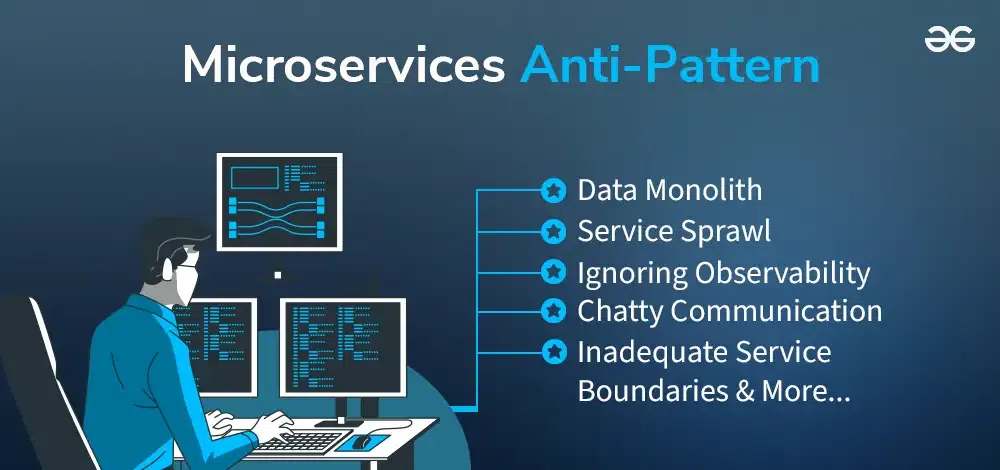
|
|
Microservices architecture has received a high reputation in recent years due to its capacity to improve scalability, flexibility, and maintainability in software architecture. However, like every architectural approach, it isn’t always without its challenges. One of the tremendously challenging aspects of implementing microservices is avoiding anti-patterns, which might be common practices that may appear intuitive but ultimately result in inefficiencies, complexities, and maintenance headaches.
In this article, we will delve into the top seven microservice anti-patterns prevailing in 2024, along with their specified descriptions, key capabilities, and tips to mitigate their negative effect What are Microservice Anti-Patterns?Microservice anti-patterns are common pitfalls or practices in microservices structure that contradict the fundamental standards of scalability, maintainability, and autonomy. These anti-patterns often emerge from a false impression of microservices ideas or try to observe conventional monolithic concepts of microservices architecture. Identifying and addressing those anti-patterns is essential for ensuring the success of a microservices-primarily based system. Top 7 Microservice Anti-PatternsMicroservices improve the agility and scalability of software architecture. Yet, developers often face hurdles that can stall progress. Here, we are going to see the top 7 microservices anti-patterns to help developers optimize their architectures and boost scalability. 1. Monolithic Mindset in MicroservicesThe Monolithic Mindset in Microservices is a frequent anti-pattern where developers technique the layout and implementation of microservices with ideas and practices paying homage to conventional monolithic programs. Instead of embracing the major aspects of microservices structure, which includes carrier independence and autonomy, builders inadvertently create tightly coupled services with shared databases and confined autonomy. Key Features
By adopting these concepts, builders can ruin loose from the Monolithic Mindset and absolutely leverage the blessings of microservices architecture, inclusive of increased scalability, flexibility, and maintainability. 2. Data MonolithThe Data Monolith anti-pattern in microservices architecture takes place when more than one microservices share a centralized database, resulting in information coupling and inhibiting the impartial evolution and scalability of sytem. Instead of adhering to the principles of microservices, where each provider ought to have its very own database and be accountable for its statistics, this anti-pattern reintroduces the challenges of monolithic data control into a microservices environment. Key Features
By implementing these recommendations, organizations can mitigate the Data Monolith anti-pattern, fostering greater independence, scalability, and resilience within their microservices architecture. 3. Chatty CommunicationChatty Communication is an anti-pattern in microservices architecture where services excessively exchange fine-grained messages, leading to increased network overhead and decreased performance. Instead of employing efficient communication strategies, such as batching or using coarse-grained messages, services interact frequently, negatively impacting system responsiveness. Key Features
By adopting these recommendations, organizations can reduce the impact of Chatty Communication and ensure efficient communication within their microservices architecture. 4. Inadequate Service BoundariesInadequate Service Boundaries occur when microservices have poorly defined boundaries, resulting in services that are either too coarse-grained, leading to bloated functionalities, or too fine-grained, causing excessive service interactions. This anti-pattern undermines the modularity and maintainability goals of microservices architecture. Key Features
By adhering to those suggestions, groups can set up clear and effective carrier obstacles, mitigating the risks associated with the Inadequate Service Boundaries anti-pattern and selling a extra maintainable and scalable microservices structure. 5. Service SprawlService Sprawl is an anti-pattern in microservices structure in which an agency creates an excessive variety of microservices with out right governance or consideration . This leads to expanded management overhead and complexity, undermining the manageability and comprehensibility of the microservices environment. Key Features
By adopting those guidelines, businesses can mitigate the risks associated with Service Sprawl and foster a greater workable and sustainable microservices atmosphere. 6. Over-Reliance on OrchestrationOver-Reliance on Orchestration is an anti-pattern in microservices architecture in which corporations rely too closely on orchestration gear and frameworks, including Kubernetes or Docker Swarm. This can lead to complex orchestration good judgment embedded within microservices, hindering carrier autonomy and portability. Key Features
By adopting these pointers, agencies can mitigate the risks related to Over-Reliance on Orchestration and make certain that their microservices architectures continue to be scalable, agile, and transportable across one of a kind environments. 7. Ignoring ObservabilityIgnoring Observability is an anti-pattern in microservices architecture where organizations neglect practices such as logging, monitoring, and tracing. This neglect can impede the ability to debug issues, analyze performance, and ensure system reliability, ultimately undermining the reliability and maintainability goals of microservices architecture. Key Features
By adopting these hints, organizations can mitigate the risks related to Ignoring Observability and ensure that their microservices architectures are ready to meet the demands of current, allotted systems. Proper observability practices allow groups to proactively identify and deal with issues, optimize performance, and supply dependable and resilient microservices-based applications.
ConclusionIn conclusion, navigating the complexities of microservices structure calls for a eager expertise of not unusual pitfalls and anti-patterns. By spotting and addressing those challenges, agencies can harness the total ability of microservices to acquire scalability, agility, and maintainability of their software structures. From overcoming the Monolithic Mindset to heading off Ignoring Observability, every anti-pattern offers specific barriers that must be conquer to realize the promised blessings of microservices. By adopting high-quality practices, fostering a lifestyle of observability, and embracing ideas together with carrier independence and clean obstacles, groups can mitigate the dangers associated with microservice anti-styles. Through diligent governance, normal opinions, and adherence to architectural ideas, companies can navigate the complexities of microservices architecture with self confidence, delivering resilient, adaptable, and scalable software solutions to fulfill the demands of brand new digital panorama Top 7 Microservice Anti-Patterns in 2024 – FAQsWhat are microservice anti-styles?
Why are microservice anti-patterns unfavourable?
How can organizations avoid microservice anti-patterns?
|
Reffered: https://www.geeksforgeeks.org
| GBlog |
Type: | Geek |
Category: | Coding |
Sub Category: | Tutorial |
Uploaded by: | Admin |
Views: | 15 |